SECM
Standardized Excel
Certification Model
Our certification model enables the development and validation of key Excel skills—from basic to expert level—through a structured, practical, and measurable progression.
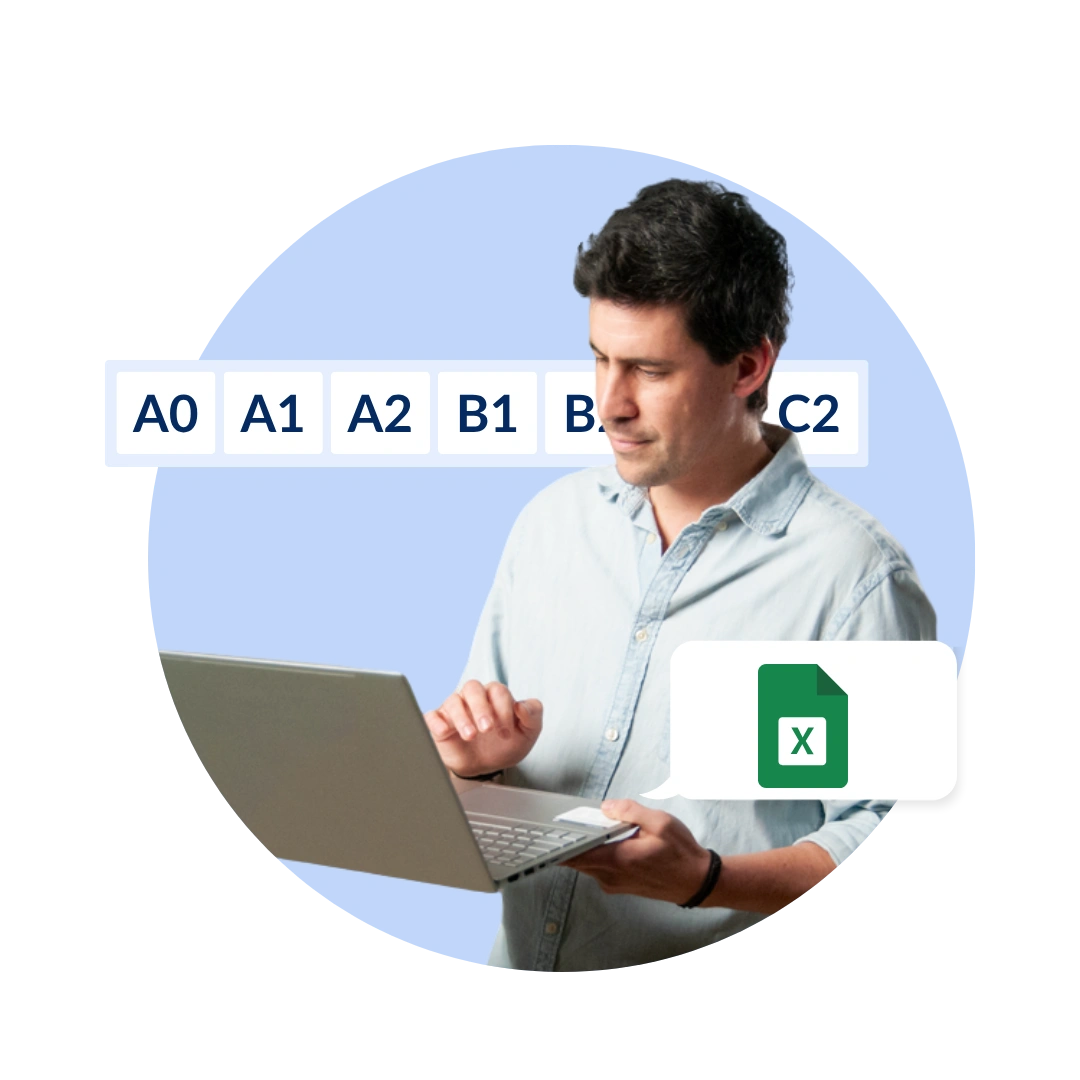
+2,000 companies trust us






SECM » Excel Courses » Excel Certifications
A0
Intro Level
-
63 min.
-
28 classes
-
5 units
-
Final Exam
-
Characteristics:
-
Lifetime access to glossary and course material.
-
100% Learning by Doing.
-
Certificate on completion.
-
Objetive:
-
Your team will understand the most basic navigation and use of Excel, such as the menus, the spreadsheet interface, the most important tricks and shortcuts when navigating, and the essential cell formats (fonts, colors, borders, etc.).
Units
- Introduction and Objectives
- Tabs
- Ribbon and Group
- Contextual Tabs
- Grid
- Name Box
- Sheets
- Formula Bar
- Status Bar
- Summary & Glossary 2
- Second Assesment
- Scroll Bars
- Zoom-in and Zoom-out
- Keyboard Navigation
- Selecting Cells with Mouse
- Select Cells with Keyboard
- Tab and Enter
- Summary & Glossary 3
- Third Assesment
- Insert/Delete Columns and Rows
- Column and Row Sizes
- Undo and Redo
- Quick Access Toolbar
- Freeze Panes
- Summary & Glossary 4
- Fourth Assesment
- Enter Data
- Edit Data
- Cell Fill (Fill Color)
- Cell Fill (Gridline Style)
- Save
- Font
- Borders
- Alignment
- Summary & Glossary 5
- Fifth Assessment
A1
Beginner
-
128 min.
-
36 classes
-
6 units
-
Final Exam
-
Characteristics:
-
Lifetime access to glossary and course material.
-
100% Learning by Doing.
-
Certificate on completion.
-
Objetive:
-
Your team will understand basic cell formats such as combining, styling and formatting cells (date, text, percentage, number, etc.). In addition, they will be able to sort data using filters, adding design and security to the spreadsheet. Finally, they will understand the use, logic, and syntax of the most basic Excel functions.
Units
- Center text across multiple cells
- Change text orientation
- Merge Cells
- Applying Cell Styles
- Format Numbers in Cells
- Format Text in cells
- Format Numbers as Percentages
- Format Numbers as Currency
- Create a Cell Style
- Summary & Glossary 1
- First Assesment
- Data Preparation
- One-Level Sort
- Multi-Level Sort
- Auto Fill
- Flash Fill
- Drop-down List
- Cells and Range Names
- Summary & Glossary 2
- Second Assesment
- Prepare Data to Filter
- Clear Filters
- Filter by specific words
- Text Filters
- Filter by specific dates
- Filter Multiple
- Columns
- Summary & Glossary 3
- Third Assesment
- Create and Apply Custom Views
- Page Layout
- Reference data in another workbook
- Summary & Glossary 4
- Fourth Assesment
- Protect Sheet
- Unlock Cells
- Hide Formulas
- Protect Workbook
- Summary & Glossary 5
- Fifth Assesment
- What is a Formula?
- Addition, Subtraction, Multiplication, and Division
- Calculation Order
- Cell References
- Copy and Paste Formulas
- Absolute References
- Mixed References
- Summary & Glossary 6
- Sixth Asessment
A2
Elementary
-
155 min.
-
41 classes
-
6 units
-
Final Exam
-
Characteristics:
-
Lifetime access to glossary and course material.
-
100% Learning by Doing.
-
Certificate on completion.
-
Objetive:
-
Your team will understand basic cell formats such as combining, styling and formatting cells (date, text, percentage, number, etc.). In addition, they will be able to sort data using filters, adding design and security to the spreadsheet. Finally, they will understand the use, logic, and syntax of the most basic Excel functions.
Units
- What is a Function?
- Create a Function
- Advantages
- Operations within functions
- Errors
- Summary & Glossary 1
- First Assessment
- SUM Function
- ROUND Function
- COUNT and COUNTA Function
- COUNTBLANK Function
- MAX and MIN Function
- Functions within Functions
- Summary & Glossary 2
- Second Assessment
- AVERAGE, MEDIAN and MODE.SNGL functions
- SUMPRODUCT Function
- LARGE and SMALL Functions
- RAND and RANDBETWEEN Functions
- More mathematical Functions
- Summary & Glossary 3
- Third Assessment
- If Function
- AND / OR Functions
- Nesting, IF, AND, OR Functions
- SUMIF Function
- COUNTIF Function
- COUNTIFS Function
- SUMIFS Function
- IFERROR Function
- IFS Function
- Summary & Glossary 4
- Fourth Assessment
- Create a Table
- Table Styles
- Sort and Filter
- Slicer
- Convert and Resize Table
- Table Style Options
- Summary & Glossary 5
- Fifth Assessment
- Chart Essentials
- Creation and elements of a chart
- Chart Formatting
- Bar Charts
- Line Charts
- Combo Charts
- Pie Charts
- Doughnut Charts
- Funnel Charts
- Sparklines
- Summary & Glossary 6
- Sixth Assessment
B1
Intermediate
-
161 min.
-
43 classes
-
6 units
-
Final Exam
-
Characteristics:
-
Lifetime access to glossary and course material.
-
100% Learning by Doing.
-
Certificate on completion.
-
Objetive:
-
Your team will be well versed in time, date, and text functions. They will also be able to outline and forecast data. Finally, they will be able to build Pivot Tables and Charts.
Units
- RIGHT and LEFT
- SEARCH – FIND
- MID
- REPLACE – SUBTITUTE
- CONCAT
- TEXTJOIN
- TEXTBEFORE-TEXTAFTER
- TRIM
- PROPPER-UPPER-LOWER
- LEN
- Summary & Glossary 1
- First Assessment
- Sum Time
- Covert Time Units
- TIME
- HOUR-MINUTE-SECOND
- NOW-TODAY-TODAY+N
- DATE-DAY-MONTH-YEAR
- EDATE-EOMONTH
- DATEDIF
- WORKDAY
- NETWORKDAYS
- WORKDAY.INTL
- NETWORKDAYS.INTL
- Summary & Glossary 2
- Second Assessment
- Group
- Auto Outline
- Subtotals
- Summary and Glossary 3
- Third Asssessment
- Show Scenarios
- Create Scenarios
- Goal Seek
- Create Forecast
- Data Table
- Summary & Glossary 4
- Fourth Assessment
- Pivot Table and its characteristics
- Create Pivot Tables, Drag and Sort fields
- Pivot Table Options
- Refresh Pivot Table
- Tables to design Pivot Tables
- Value Field Settings
- Filter and Sort Pivot Tables
- Design and Move Pivot Tables
- Manual and Automatic Groupings
- Protection and Pivot Tables
- Summary & Glossary 5
- Fifth Assessment
- Create Interactive Charts from Tables
- Create Pivot Chart
- Pivot Chart Tools
- Summary & Glossary 6
- Sixth Assessment
B2
Upper Intermediate
-
150 min.
-
38 classes
-
6 units
-
Final Exam
-
Characteristics:
-
Lifetime access to glossary and course material.
-
100% Learning by Doing.
-
Certificate on completion.
-
Objetive:
-
Your team will have knowledge of lookup functions such as VLOOKUP and advanced conditional functions. They will also be able to use other advanced data tools. Finally, they will be able to use custom Pivot Table tools.
Units
- Preset Rules
- Detect Duplicate Values
- Top and Botton 10 Rules
- Data Bars and Color Scales
- Icon Sets
- Manage Rules
- Clear Rules
- Rules with Formulas
- Summary & Glossary 1
- First Assessment
- Text to Columns
- Remove Duplicates
- Consolidate
- Summary & Glossary 2
- Second Assessment
- Data Validation
- Input Message
- Error Alert
- Whole Number
- Date
- Text Length
- List
- Dependent Drop-Down Lists
- Summary & Glossary 3
- Third Assessment
- TRANSPOSE
- VLOOKUP
- HLOOKUP
- COLUMN-ROW
- COLUMN-ROWS
- MATCH
- INDEX
- IF-VLOOKUP
- IFERROR-VLOOKUP
- INDEX-MATCH
- Summary & Glossary 4
- Fourth Assessment
- Trace Precedents
- Trace Dependents
- Show Formulas
- Evaluate Formula
- Error Checking
- Summary and Glossary 5
- Fifth Assessment
- Slicers in Pivot Tables
- Timeline
- Create Individual Reports
- Refresh and Group Data
- Summary & Glossary 6
- Sixth Assessment
C1
Advanced
-
163 min.
-
36 classes
-
6 units
-
Final Exam
-
Characteristics:
-
Lifetime access to glossary and course material.
-
100% Learning by Doing.
-
Certificate on completion.
-
Objetive:
-
Your team will have a deep understanding of pivot tables, filters, validations, and advanced lookup functions. In addition, they will be able to create and control custom forms.
Units
- Report Connection
- Custom Slicer Style
- Multiple Consolidation Ranges (Single Page Field)
- Multiple Consolidation Ranges (Custom Page Fields)
- Calculate Field
- Calculate Item
- List Formulas
- Summary & Glossary 1
- First Assessment
- CHOOSE
- INDIRECT
- OFFSET
- HSTACK-VSTACK
- TOROW-TOCOL
- WRAPCOLS-WRAPROWS
- CHOOSECOLS-CHOOSEROWS
- Summary & Glossary 2
- Second Assessment
- XLOOKUP
- SORT
- SORTBY
- UNIQUE
- FILTER
- VLOOKUP function to cross-reference data
- Nesting VLOOKUP and INDIRECT
- functions to search in different tables
- VLOOKUP function for multipl results
- Summary & Glossary 3
- Third Assessment
- Combo Box
- Check Box
- Spin Button
- List Box
- Option Button
- Charts with Form Controls
- Conditional Formatting with Form Controls
- Summary & Glossary 4
- Fourth Assessment
- Filter by using one criterion
- Filter by using multiple criteria
- Filter by using wildcard characters
- Obtain unique records
- Summary & Glossary 5
- Fifth Assessment
- Prevent Duplicate Data Records
- Avoid transcribing irregular spaces
- Dynamic ranges with the OFFSET function
- Summary & Glossary 6
- Sixth Assessment
C2
Expert
-
126 min.
-
27 classes
-
5 units
-
Final Exam
-
Characteristics:
-
Lifetime access to glossary and course material.
-
100% Learning by Doing.
-
Certificate on completion.
-
Objetive:
-
Your team will be able to easily handle advanced Pivot Tables, in addition to using Macros and Solver in their daily tasks, understanding their power and syntax.
Units
- Nesting FIND and MID Dynamic Data Extraction
- Nesting MID and Double-Nesting FIND for Dynamic Data Extraction
- Nesting FIND and LEFT for Dynamic
- Data Extraction
- TEXTSPLIT function
- Summary & Glossary 1
- First Assessment
- RANK.EQ
- FREQUENCY
- MAXIFS
- MINIFS
- AVERAGEIF
- AVERAGEIFS
- Summary & Glossary 2
- Second Assessment
- Show Values As: % of Grand Total
- Show Values As: % of Column Total
- Show Values As: % of Row Total
- Show Values As: % Of
- Difference from
- % Difference from
- Running Total in
- Summary & Glossary 3
- Third Assessment
- Fundamentals of Excel Macros
- PC Settings to work with Macros
- Record, Run, and Delete a Macro
- Copy a Macro to another workbook
- Create a Form with Macros
- Advanced Filters with Macros
- Summary & Glossary 4
- Fourth Assessment
- Enable the SOLVER Add-in
- Working with SOLVER
- Working whit Maximum Objetives in SOLVER
- Working with Minimum Objetives in SOLVER
- Summary & Glossary 5
- Fifth Assessment
Excel Certifications That Validate Real Learning
Certify your team's skills with credentials that reflect a structured, applied learning process. Each completed course grants a certificate that’s part of a progressive learning path — measurable, relevant, and aligned with real workplace needs.
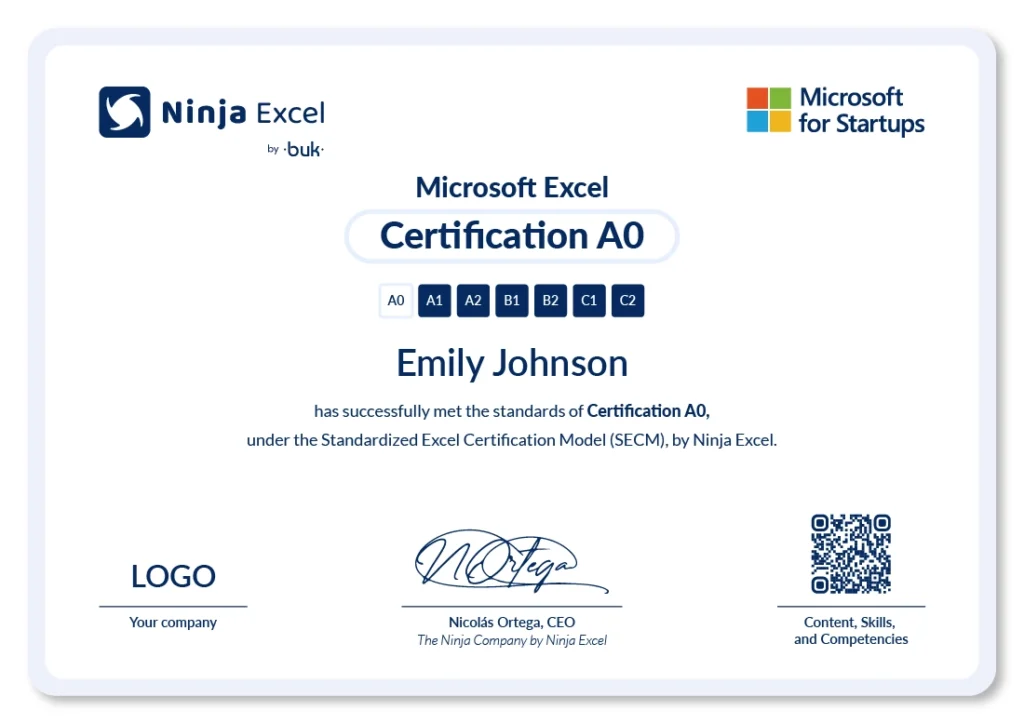
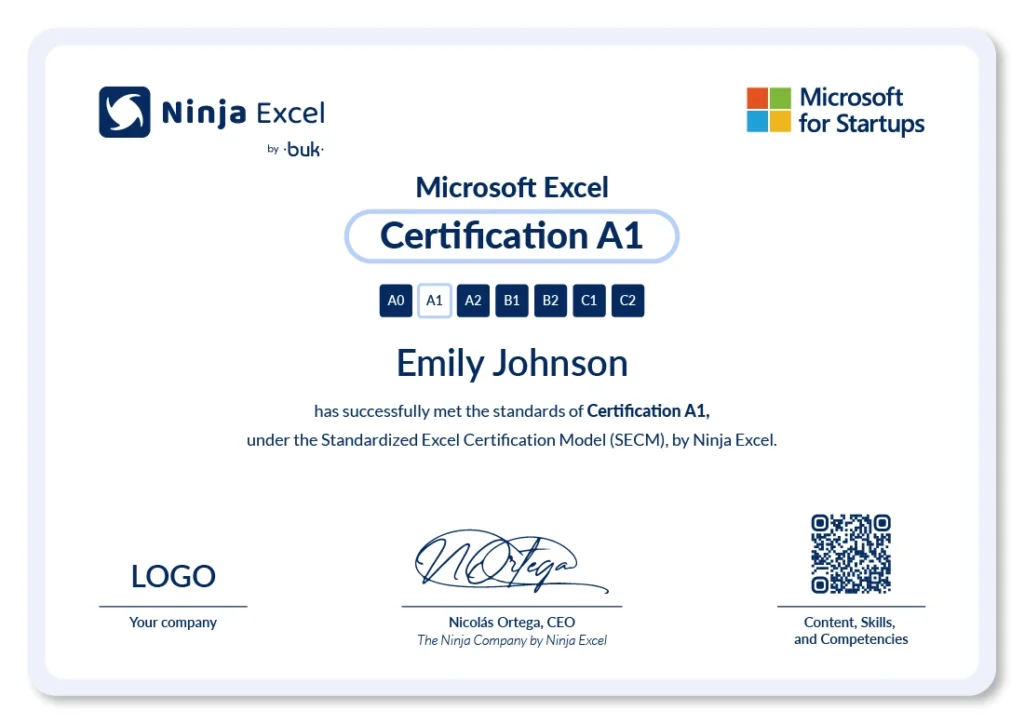
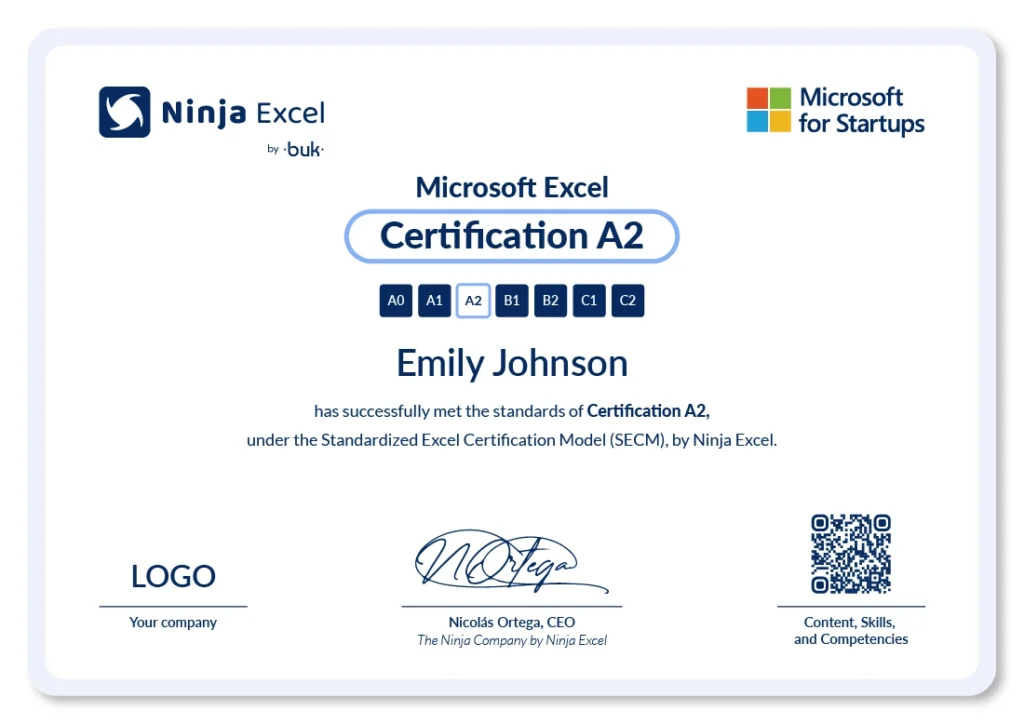
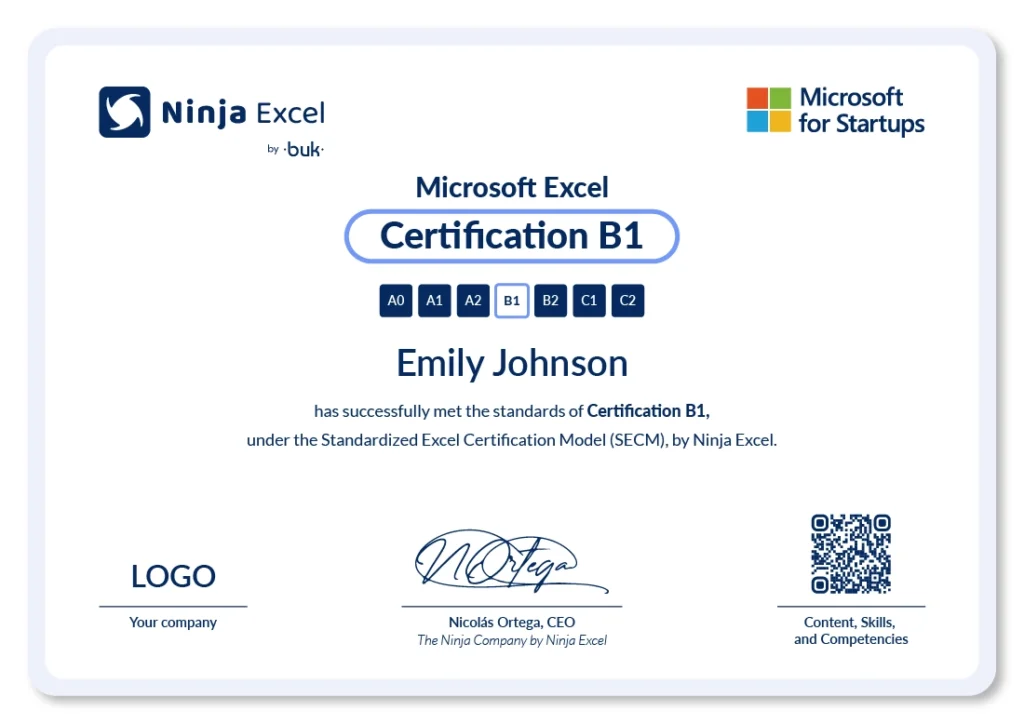
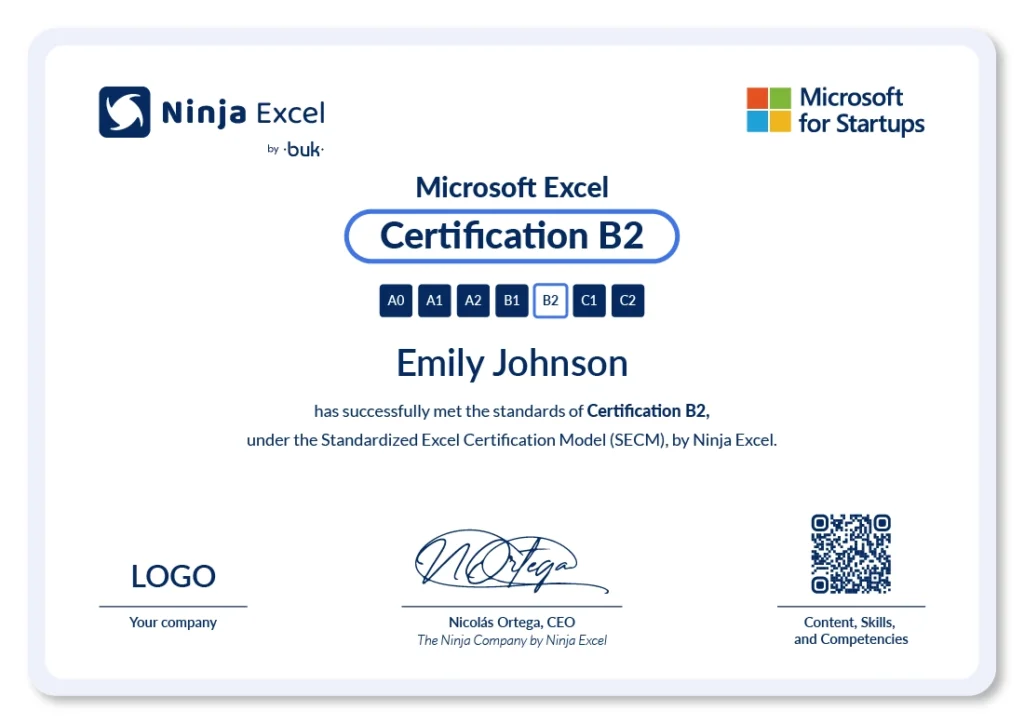
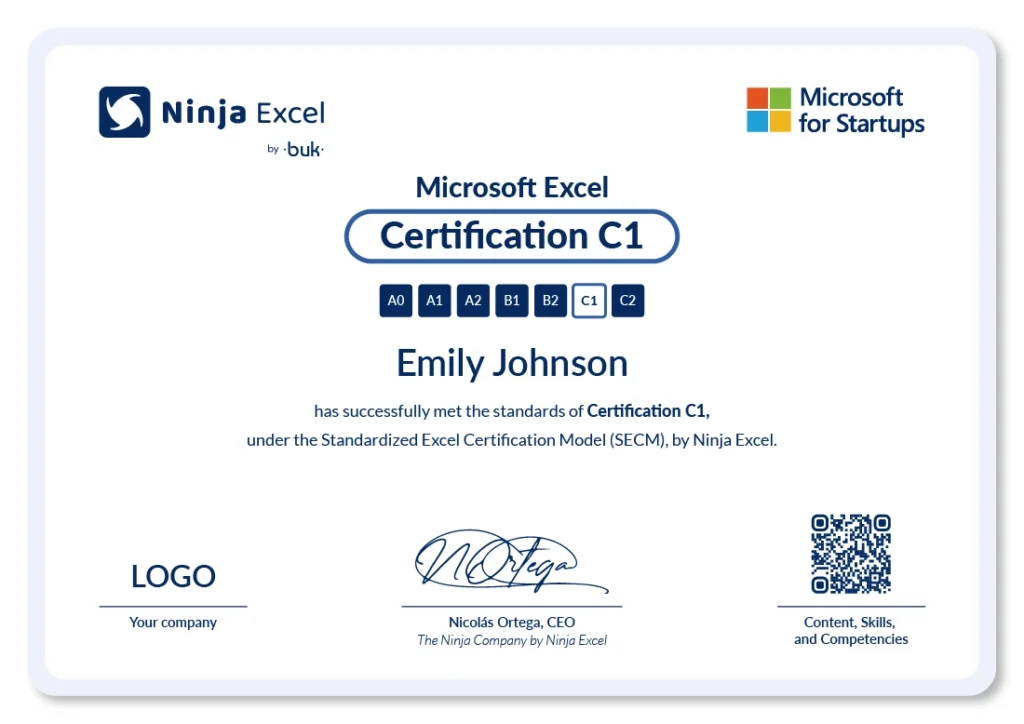
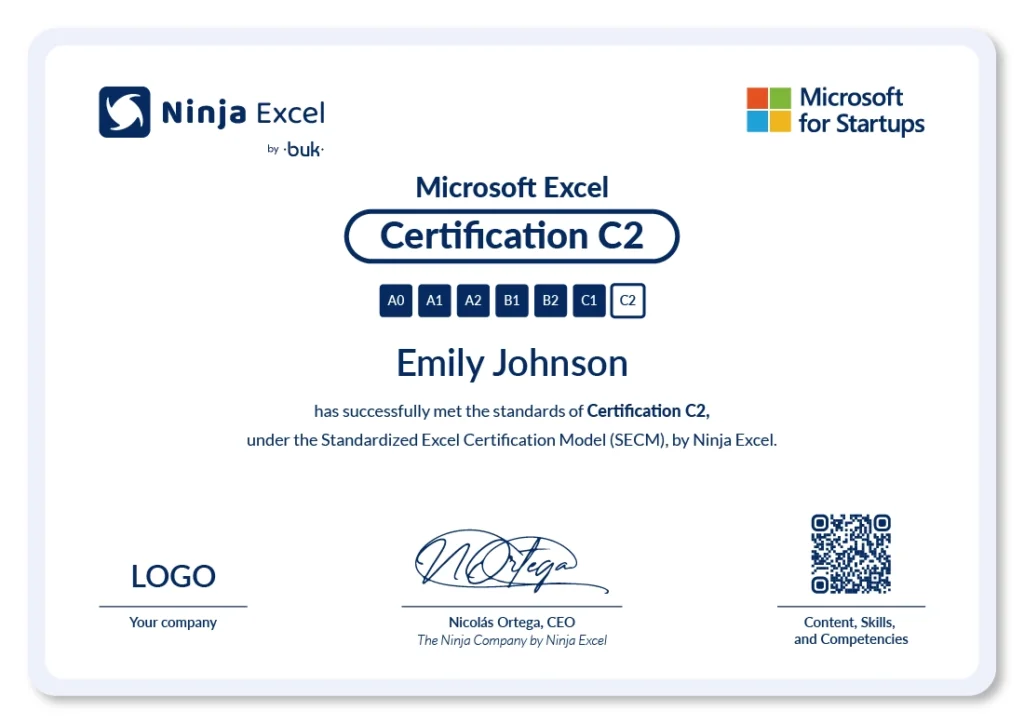
-
Certification by Level (A0 to C2)
Each completed stage is accredited with an individual certificate that proves technical progress.
-
QR Code with Skill Breakdown
Each certificate includes a unique QR code that lists the skills and tools acquired.
-
Shareable on LinkedIn and CVs
Certificates can be added to professional profiles or resumes to showcase proven Excel expertise
What
our clients say
"After Ninja Excel, the improvement in our teams was clear: the training was valuable, and the quality of our reports marked a turning point."
Javier Isla
"The support team at Ninja Excel is awesome! Thank you all so much!
You all make it a great process and easy to work with!"
Carly Thompson
“Working with Ninja Excel has been a great experience.”
Andrea Garrido
“The platform brings together the videos, solutions, and exercises in one place. That helps employees learn by doing.”
Ana María Calvo
Empower your teams with
high-impact training
Schedule a call with us and boost your organization’s Excel capabilities today.
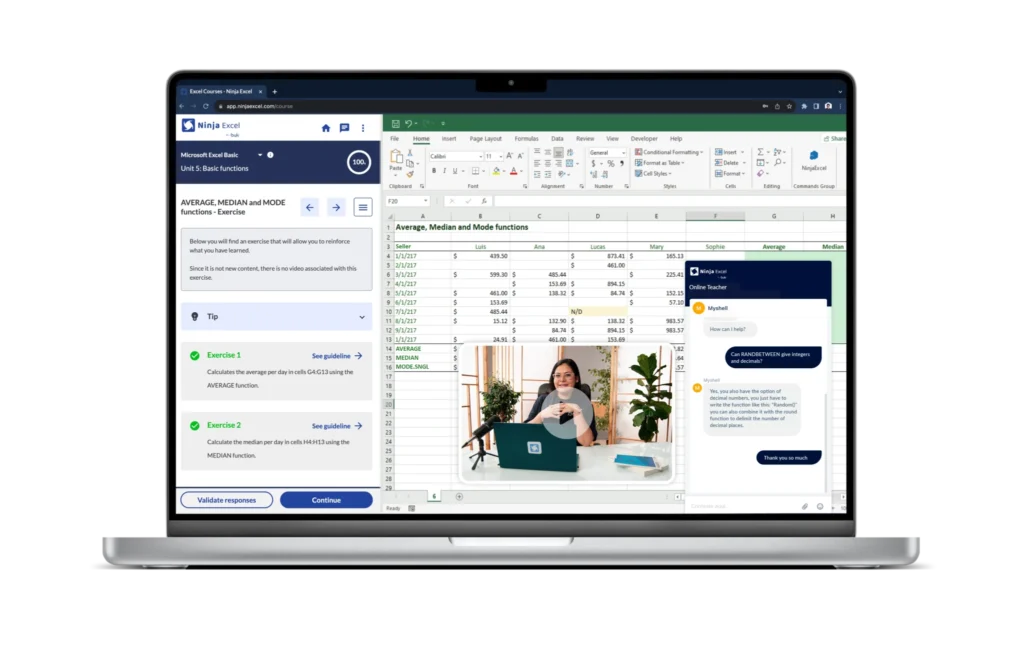
Frequently Asked Questions
Take a look at some of the most common questions our clients ask.
Each course includes:
Short, practical video lessons.
Interactive exercises completed directly within Microsoft Excel via streaming.
Automatic feedback on every activity.
Unit assessments and a final exam.
A professional certificate for each completed level.
All content is designed using the learning by doing methodology, so learners can apply what they’ve learned from the very first class.
The content is organized by level and specific skills, ranging from A0 to C2.
You can request the Ninja Excel Test, a practical, untimed assessment with 30 questions.
At the end, you’ll receive a report via email with the recommended course level for each team member.
The courses are organized by proficiency level:
A0 to A2: From basic navigation to conditional functions and charts.
B1 and B2: Analysis tools, data validation, and pivot tables.
C1 and C2: Automation, macros, dashboards, and advanced data analysis.
Each level grants an independent certification and includes exercises aligned with real-world job challenges.
The levels range from basic Excel use (A0: interface and navigation) to advanced tasks like macro automation and dashboard creation (C2).
Each level develops specific skills and aligns with practical competencies for daily work.
Yes. Users can access all content anytime, from anywhere.
There are no fixed schedules or mandatory live sessions.
Teams can progress at their own pace and repeat exercises as many times as needed.
No. Our platform is integrated with Microsoft Excel via streaming, so there’s no need to install Excel or leave the learning environment.
The entire course—lessons, exercises, feedback, and navigation—takes place within the real Excel environment, with no simulators or extra setup required.
All you need is an internet connection to start practicing from anywhere.
Yes. Each completed course and level grants a professional certificate that validates specific Excel skills, depending on the completed level (A0 to C2) or specialization program.
Yes. Ninja Excel is designed for training entire teams.
You can request a demo or personalized consultation to manage bulk enrollments, progress tracking, and consolidated reporting.
We use real Microsoft Excel, not simulators.
Content adapts to progressive skill levels.
Over 400 exercises based on real-world work situations.
Automatic feedback and support from Microsoft Certified Trainers.
Everything happens in one platform—no switching environments or installing software.
Yes. You can book a free demo to explore the platform, the learning methodology, and how the courses fit your organization’s needs.
 Excedentes SENCE vencen el 31/12.
Excedentes SENCE vencen el 31/12. 